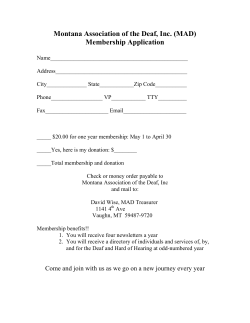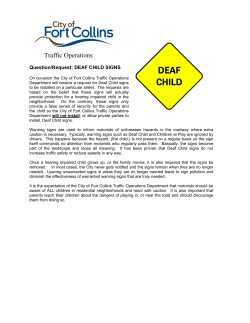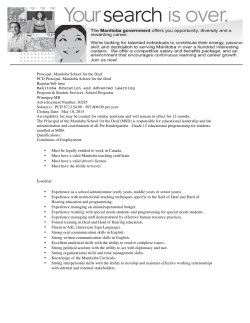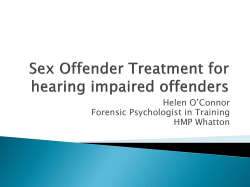
Session 4 â Student Presentation 1, Robyn Swannack
“No Ears Allowed”: An Anthropological Exploration of the International Symbol of Deafness Robyn Swannack The International Symbol of Deafness What is this sign actually saying? My ears look the same as any Deaf person – Hearing South African, age 34 Does this sign mean no ears allowed? No hearing people allowed? No Deaf people allowed? Deaf people do not have access? Symbolic Representation The international symbol of Deafness is a symbolic representation of Deaf people and intended to inform them as well as others in terms of: Their presence and access in certain places; It is used to define deafness; It is used by medical professions to indicate deafness in a patient. Signs The forward slash on a sign or symbol is commonly accepted as a sign of prohibition i.e. you are not allowed. The sign poses an ambiguity in that the forward slash on the international symbol of Deafness can be represented as prohibition, however in this case, the forward slash represents ‘a lack of’. Data Collection There were three specific views of the symbol in the interviews. Firstly, the symbol was considered an unacceptable use of sign to identify or describe deafness. Secondly, the symbol was considered to have been based on medical discourse. Thirdly, the symbol was considered an acceptable way to describe the deafness and some were thoroughly pleased with the use of sign. Interviews My first thought was “Why are you doing this? Are you treating me like I must block my ears even if I could hear a little enough?” It seems like you’re saying “Please, it’s okay. Remember what this symbol is for. It’s for hearing people to be aware.” You seem to have upset me because you seem to have cut my ears off like this symbol [sic.]. Deaf South African, age 27 I am very against this symbol. It indicates me that the ear is blocking and deafness is a sign. What does it supposed to mean? Deafness affected deaf people that they cannot do anything because they just cannot hear? The way how deafness shows the symbol is a discrimination. I feel it is abusing our Deaf culture. We need to be treated equally, and use our hands as a symbol of Sign Language would be much better. Deaf culture is mostly about visual language which is hands for Sign Language. What’s wrong with using hands? Sign Language is an exquisite language. Deaf South African, age 23 Medical and Social Approaches Medical (Pathological) Social (Sociocultural) - Emphasis on disability - Belief that Deaf people need to be cured or ‘fixed’ - Deaf children are given cochlear implants and hearing aids, normally without the child’s consent - Focuses on the teaching of lip reading and spoken language to ‘fit in’ with the Hearing world - Emphasis on Deafness as a culture - The philosophy of a Deaf Community and Deaf Identity - Focus on the teaching of relevant Sign Language in order to ‘fit in’ with the Deaf community Hearing people’s responses I feel as this symbol is semi-okay as with the way people are today. It could have been more crudely done (i.e. no smoking sign except with an ear – which I find super offensive). I do find that since I didn’t actually know what the symbol was, until you explained it, I realized that MORE people should be made aware of it. Especially people who aren’t deaf, since the majority don’t come in contact with deaf people or take the time to try and communicate with deaf people. Hearing South African, age 21 Norm I do not like it as it focuses on what the Deaf cannot do as opposed to what they can. Although not being able to hear is defining characteristic of deafness so is Sign Language so I would prefer that there is a focus on the positive and not the medical diagnosis in designing a symbol for deafness. I find it unacceptable, as it defines a deaf person in negative terms in the same way that black people were labelled non-white under apartheid. It defines a deaf person by comparing them to the “norm” of hearing and saying how they lack. Hearing South African, age 38 South Africa vs. Overseas I do not have a problem with this symbol as this is an internationally recognised sign for “No Hear” and is often used to represent people with disabilities. Some Deaf people dislike the symbol as the symbol brings attention to their ‘deficiency’ not their language and ability which is Sign Language. Deaf American, age 47 South Africa vs. Overseas I find nothing wrong with this symbol. For me it means the awareness for hearing people that there is deaf people around. But I dislike the one-cross over the ear, we are not ear-broken. But the symbol should be designed in the culturally way that defines Deaf people instead of using their ear. How would blind people feel if their symbol is cross over eye instead of walking stick symbol? How would wheelchair people feel if their symbol is a person with cross over legs instead of the wheelchair symbol? I guess it depends on what circumstances are. Deaf South African, age 29 Conclusion
© Copyright 2025









